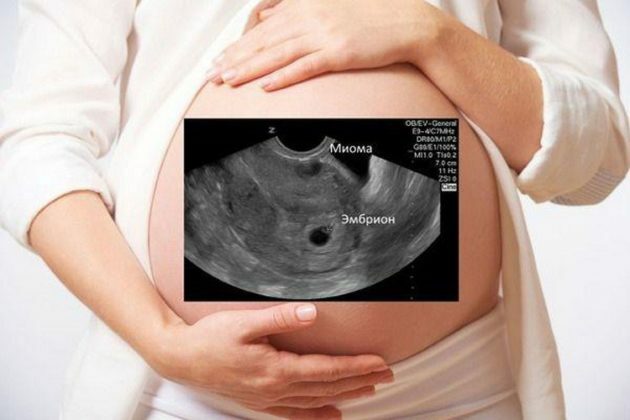Content
- 1 Is it possible to confuse uterine fibroids with pregnancy
-
2 How to distinguish fibroids from pregnancy
- 2.1 Similarities
- 2.2 Differences
- 3 Is it possible to confuse uterine fibroids with another disease
- 4 Conclusion
Fibroids are benign growths in the uterine cavity that grow from immature myocytes formed in the myometrium. It appears more often due to inflammatory processes, and also often occurs as a hereditary factor. Many women wonder how to distinguish fibroids from pregnancy, since in the early stages it is often possible erroneous definition of the fetal egg as a neoplasm, which is often caused by the incompetence of the specialist conducting ultrasound.
Is it possible to confuse uterine fibroids with pregnancy
In the early stages of diagnosis, doctors can confuse fibroids with pregnancy. This is due to the fact that the neoplasm node has some similarities with the initial stage of fetal development in shape and size. This is especially noticeable in the fifth week of gestation. The gestation period is always accompanied by a lack of menstruation, however, hormonal failure caused by tumor growth also often causes a delay in monthly bleeding.
As a result, the woman thinks that she is in a position, although in fact a benign tumor has formed in the uterine cavity, which can actively grow.

The reason for mistaking fibroids for gestation is often not very good ultrasound equipment.
How to distinguish fibroids from pregnancy
The phenomenon when pregnancy was confused with fibroids on ultrasound can be caused by two reasons:
- The incompetence of the specialist conducting the diagnosis.
- Malfunction of equipment that gives out a neoplasm for a fetal egg.
Important! An additional study is needed to accurately determine the patient's condition.
Similarities
Both pathologies have several similar features:
- an increase in the abdomen, especially if the fibroid has an impressive size, causing the expansion of the uterus and its "bulging";
- lack of menstruation, with neoplasm, the delay is caused by hormonal failure;
- pain in the lumbar region.
Additional confusion is caused by the generally accepted gynecological practice of counting the size of the pathological node in weeks, as happens during pregnancy. However, the gestation period is normally not accompanied by pulling pains in the abdomen, as is often the case with a neoplasm.
Differences
The differences between gestation and fibroids, in fact, are much more than similar signs. These include:
- The absence of toxicosis and drowsiness, characteristic of the gestation period.
- A delay in menstruation caused by hormonal failure does not always appear and is of a short duration.
- The hCG test performed for uterine fibroids is not informative, it is usually below average or low. While during an actively developing pregnancy, there is a constant increase in the hormone gonadotropin.
- During pregnancy, the uterus remains elastic and soft, respectively, for an accurate diagnosis, an examination on a gynecological chair will be useful.
Warning! An actively growing fibroid is always accompanied by painful sensations.
There are additional signs of uterine fibroids on ultrasound that can distinguish it from a developing pregnancy:
- the cavity of the organ is characterized by a fuzzy intermittent contour;
- part of the M-echo of the median localization is partially displaced;
- formations caused by the formation of nodes are echoed clearly.
Important! Since discharge in the middle of the cycle is possible with a neoplasm, a woman can independently determine the presence of a tumor.
Is it possible to confuse uterine fibroids with another disease
Since the appearance of a benign tumor in the uterine cavity is rapidly “younger”, there is a high risk of confusing it with pregnancy. Ultrasound diagnostics is not the "last resort" in making the correct diagnosis. Both pregnancy and fibroids at the initial stage of development look almost the same on ultrasound. An accurate diagnosis is possible only with a differentiated examination, which includes blood sampling to determine the level of hCG, as well as an examination on a gynecological chair.

An actively developing pregnancy is always accompanied by the appearance of an embryo, while the myoma remains a dense neoplasm.
There is also a high risk of confusing the tumor with other pathologies that have similar symptoms. More often these are polyps and cysts, accompanied by the same symptoms. However, a competent specialist will always distinguish a benign node from other neoplasms.
Conclusion
A woman can sometimes distinguish fibroids from pregnancy on her own, listening to her own feelings. However, in most cases, ultrasound diagnostics does not give a clear result, especially if the period too small and the blade equipment is not clear enough to show an embryo up to 6-8 weeks. Additional examinations in the form of a blood test for hCG and a gynecological examination can make the diagnosis more accurate.
The information and materials on this site are provided for informational purposes only. You should not rely on the information as a substitute for actual professional medical advice, assistance or treatment.
